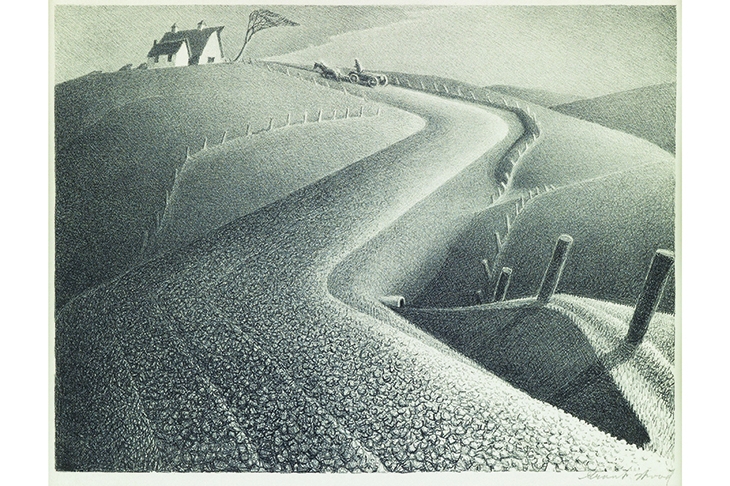Artists’ prints have been around for almost as long as the printed book. Indeed, they have similar origins in Gutenberg’s invention of the printing press and the boom in book and paper production that followed. Consequently, although the art dealer Bernard Jacobson has been around for quite a while — his gallery celebrated its 50th anniversary this year — and began as a print publisher, he arrived on the scene rather too late to have acted for Albrecht Dürer in person. Nonetheless, and for good reasons, it is with Dürer that he begins his current exhibition, Prints I wish I had published.
Dürer was the first great artist to achieve fame by selling multiple editions of engravings and woodcuts rather than unique pictures. He was also an example of another phenomenon: the draughtsman of genius whose prints were better than his paintings. The same was true of Francisco Goya, work by whom features in Jacobson’s selection, at least in the opinion of Lucian Freud (who doesn’t, but perhaps deserved a place).
This brings us to a crucial point, which is subtly made throughout this beautifully selected and presented exhibition. Namely, that prints are generally less expensive than paintings, because in more plentiful supply, but they are not necessarily inferior. Indeed, they may be just as good or better. Gauguin is another artist whose graphic work was far from secondary. He had a particular affinity for the roughness of woodcuts — there are several examples in the show — and his works in this medium were often tougher and more radical than his oils.
Some great painters make no prints at all. Others find that a certain type of print medium suits them, and stick to it. Thus Patrick Caulfield concentrated on the screenprint, of which he was a master. The flat, strong colours produced by this technique suited him perfectly, as is demonstrated by his early ‘Ruins’ (1964).
A few artists — such as David Hockney, represented by several works — restlessly move from one medium to another. Over the years, Hockney has tried out more diverse media than most. He does this, he has explained, because each has its individual strengths — things you can and can’t do in it. And moving from one to another ‘forces you to be inventive’.
A larger exhibition than this one would have been required to cover the whole range of Hockney’s work as a print-maker, but it does contain quite enough to suggest the vast range of possibilities the printing press holds for artists. There are abstract expressionist prints — among them a lovely one by the underrated Sam Francis — and splendid Japanese woodblock works by Hokusai and Hiroshige. Matisse, Samuel Palmer, Picasso and Rembrandt also feature notably. Jacobson might well wish he’d published all of these, and it would be an austere art-lover who wouldn’t covet quite a few.
Print-making media such as etching, engraving and lithography are essentially specialised types of drawing. So it’s not surprising that the list of participants in Close: Drawn Portraits at the Drawing Room overlaps with that at the Bernard Jacobson Gallery. Hockney and Picasso crop up again, together with a little pencil study from 1814 by Ingres.
In fact, these three form a lineage: at one stage, Picasso channelled Ingres, and in a drawing such as his free-flowing, supremely confident pen-and-ink study of the critic Marco Livingstone from 1980, Hockney was following both the others.
As this example implies, there are some choice things to be seen in this selection of works by artists familiar and unfamiliar, old and new. It contains some unexpected things including an extraordinary sequence of self-portraits by Paula Rego from 2017, done after she had injured her face in a fall and when she had recently left hospital, still shaken. In these pastels, Rego, heavily bruised and gashed, looks as if she has been reconfigured by Francis Bacon.
A multi-part sequence by Dryden Goodwin, ‘A Day with my Father, a Day with my Son’, is still newer, commissioned last year for this exhibition. It is a meditation on intimacy, to which portrait drawing lends itself. With just a sketch pad, pen or pencil, it is indeed easier to get close, both physically and emotionally. Hockney, for example, started sketching Livingstone spontaneously as the latter sat watching TV.
Lucian Freud’s portrait from 1945 of his early patron Peter Watson makes the same point. It was several years before Freud could attain this kind of intensity — a feeling that you are getting much closer to a human face than is comfortable or conventional — with brush and pigments. This masterpiece shows how for him — as for Hockney, Ingres and Picasso — drawing literally came first. In many ways, even in this digital age, it is still fundamental.






Comments